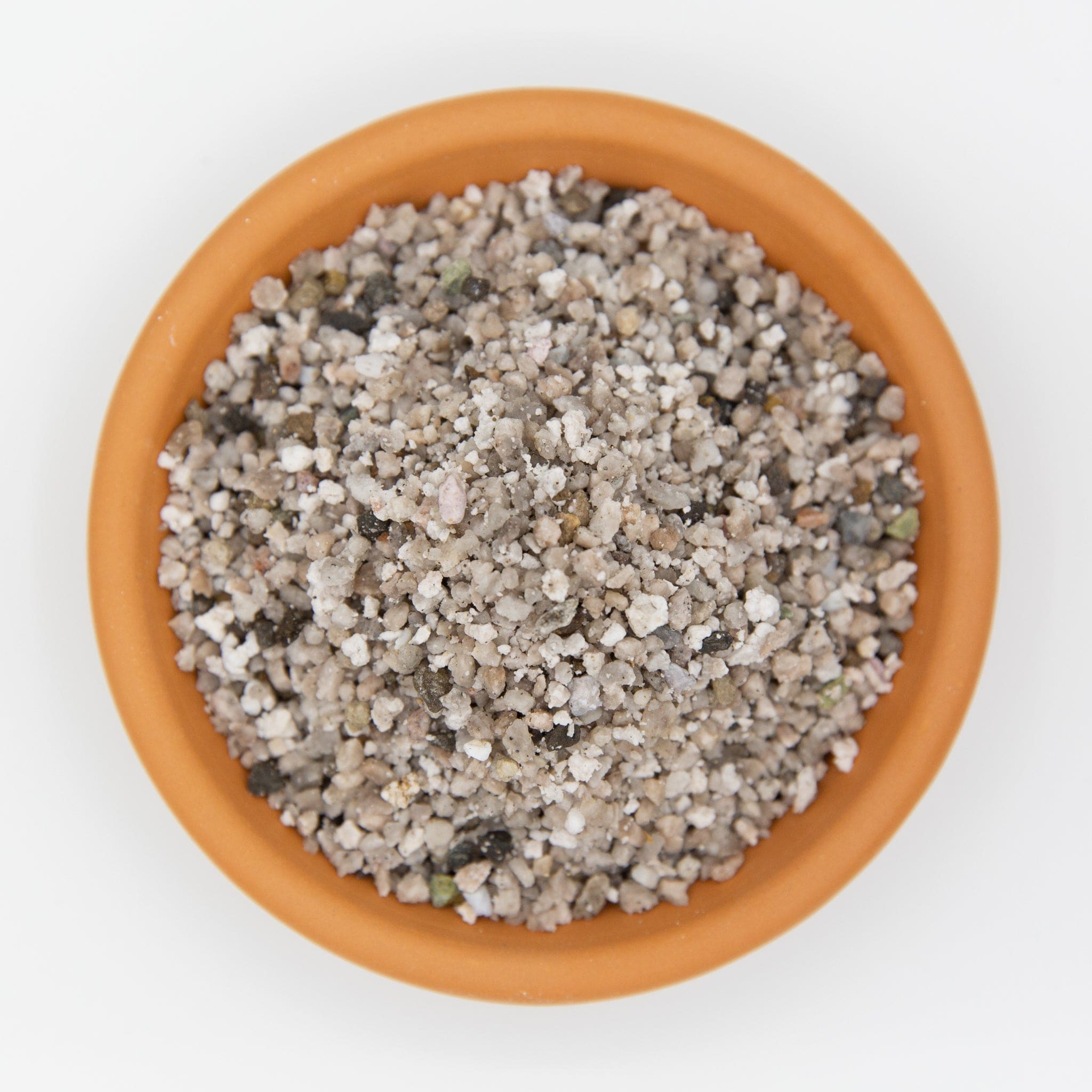Elevate your soil mix with the power of UXP Pumice—a premium, Turkish-origin horticultural pumice made from perlite ore. This all-natural mineral medium offers unparalleled aeration and drainage, helping roots breathe while retaining essential moisture and nutrients.
Unlike traditional perlite or coarser grades of pumice, UXP’s uniform texture prevents separation from soil mixes, making it a reliable and long-lasting solution for plant health.
Features
-
Ideal for cactus, succulents, bonsai, and organic gardening
-
Made from high-quality perlite ore
-
Uniform grade that blends seamlessly into soil
-
Superior drainage without sacrificing moisture retention
-
Won’t float or separate like standard perlite
-
Approx. 1L volume per 800g
-
Available in 5L, 10L, and 30L bag options
Why You Should Buy
If you’re frustrated by perlite constantly surfacing and separating from your potting mix, UXP Pumice is the upgrade your plants deserve. Its dense but porous structure enhances aeration while maintaining soil stability, perfect for root-sensitive plants like cacti, succulents, and bonsai. Whether you're mixing a custom blend or improving your current soil, UXP Pumice provides consistent performance and peace of mind. Its compatibility with organic and no-till systems makes it a top pick for both hobbyists and professional growers.
FAQs
What exactly is UXP Pumice 1–5mm?
A premium, Turkish-origin horticultural pumice (made from perlite ore) graded to ~1–5 mm, designed to boost aeration and drainage while still holding a bit of moisture for roots. It blends evenly and doesn’t separate out of mixes.
What bag sizes are available and how much does each weigh?
It’s available in 5 L, 10 L and 27 L. As a guide, this pumice is ~800 g per litre, so ~4 kg (5 L), ~8 kg (10 L) and ~21–22 kg (27 L).
Is UXP Pumice 1–5mm natural and safe for organic gardening?
Yep—mined, inert, chemical-free, and suitable for organic/no-till systems.
Why choose pumice over perlite?
Pumice is denser so it stays put in the mix instead of floating to the top like perlite. It also adds a long-lasting structure. Great for containers you water often.
Will this pumice float?
Much less than standard perlite thanks to higher density; that’s one of the selling points.
What plants is the 1–5 mm grade best for?
Cactus, succulents, bonsai and any mix where you want fast drainage with some moisture retention. The 1–5 mm grade is a sweet spot for small to medium pots and bonsai training containers.
How much pumice should I mix into potting soil?
Common starting points: 25–50% pumice by volume. Go 50%+ for super-dry mixes (cacti/mediterranean species), closer to 25–33% for thirstier plants or smaller pots. Adjust based on your watering and climate.
Can I use UXP Pumice 1–5mm straight (100% pumice) with no soil?
You can for some succulents/bonsai, but expect to feed more often (pumice has low nutrient holding capacity). Many growers blend it with bark/akadama/lava or a potting mix for balance.
What’s the pH and nutrient holding like?
Typically near-neutral pH and low CEC (nutrient-holding). That’s why it’s stable and doesn’t mess with your recipe—but you supply nutrition via soil/ammendments or fertigation.
Do I need to wash or sieve UXP Pumice 1–5mm before use?
If a bag shows fines, a quick rinse or screen sift is nice but not mandatory. Most growers just shake out dust; wash only if you’re chasing ultra-clean bonsai/seed mixes.
Does the colour vary?
Yes—being natural, batches range from white to dark grey. If you want to check the current batch, ask us for a pic before ordering.
Is UXP Pumice 1–5mm the same as lava rock/scoria?
Different rock. Pumice (often rhyolitic) is lighter and more vesicular than scoria (basaltic). Both are useful; many bonsai and cactus growers blend them.
What’s the typical use rate for bonsai?
Common bonsai blends are 1:1:1 pumice:lava:akadama (or akadama alternatives), or 2:1 pumice:lava in training. Choose finer grains for shohin/smaller pots.
Good ratios for succulents and cacti?
Popular DIY: about 1 part pumice to 2–3 parts soil for thin-leaf succulents; equal parts (1:1) or more pumice for chunky succulents/cacti. Tweak based on pot size and watering.
Will pumice help with fungus gnats?
As a top dress, pumice can act as a physical barrier on the surface, which can deter adult gnats from laying eggs (similar to dedicated “gnat barrier” products made from pumice). It’s not a silver bullet, but it helps as part of IPM.
Is UXP Pumice 1–5mm reusable?
Yes—pumice doesn’t break down quickly. You can reuse it after cleaning/sterilising (boil, bake, or bleach-soak then rinse thoroughly) if you’re concerned about pathogens.
How do I sterilise used pumice?
Boil/steam, oven-bake, or short bleach soak (then rinse well to remove residue). Let it dry before re-potting.
Is 1–5 mm too fine for large pots?
For big pots or thirsty plants, many growers step up particle size for faster drainage. You can still use 1–5 mm; just increase percentage or blend with coarser media.
Does pumice improve aeration as well as drainage?
Yes. The porous particles create air pockets and let CO₂ escape, which encourages root growth.
Will UXP Pumice 1–5mm change my watering schedule?
Usually, you’ll water a bit more frequently than with heavy, peaty mixes (but with less risk of rot). The exact change depends on your ratio, pot size and climate.
Is UXP Pumice 1–5mm suitable for aroid mixes (Monstera, Philodendron)?
Yep—great as the mineral chunk in a chunky aroid mix alongside bark/hydroton/zeolite. It boosts structure and reduces gnat-friendly soggy fines.
Can I top-dress with pumice for looks and function?
Definitely. A 1–3 cm top layer tidies the surface, reduces splash/algæ, and can help deter fungus gnat emergence.
Does pumice add nutrients by itself?
Not meaningfully. Think of it as structure/aeration. Feed with an organic program or controlled fertigation to supply nutrients.
What’s the density—how many litres per kilo?
Rule of thumb on this product is ~1 L ≈ 0.8 kg (so ~1.25 L per kg). Always allow for natural variance between batches.
Is there dust? Should I wear a mask?
Like most mineral media, some fines can be present. If you’re sifting or pouring a lot, basic PPE (dust mask/eye protection) is just good practice. (General safety best-practice; many suppliers note low dust but recommend care.)
Can I use UXP Pumice 1–5mm in hydroponics or semi-hydro (PON-style) setups?
Yes—pumice is commonly used in mineral blends (pumice/lava/zeolite). It’s inert, provides wicking and air space, and is reusable.
Does UXP Pumice 1–5mm help prevent root rot?
Indirectly, yes. By increasing porosity and drainage, it keeps roots oxygenated and reduces waterlogging—the conditions that drive rot.
How does UXP Pumice 1–5mm compare with akadama for bonsai?
Pumice is cheaper/more available outside Japan and very durable. Many bonsai growers use it as a core component or akadama alternative, often mixed with lava/bark.
Any tips for first-time users?
Start at ~30–40% pumice for most houseplants; increase for cacti/succulents. Pre-moisten the mix, tamp lightly (don’t compact), and top-dress if gnats are an issue. Adjust after a few waterings based on dry-down time and plant response.
Will UXP Pumice 1–5mm stain, leach, or change soil chemistry over time?
Pumice is stable and near-neutral, so it doesn’t significantly alter pH or break down quickly. Nutrients still come from your compost/feeds.
What’s the best way to store bags?
Keep sealed, dry, and out of direct rain. If a bag gets wet, just dry the pumice before use to avoid clumping—no harm done. (General handling guidance for mineral media.)
Can I mix pumice with biochar, bark, or zeolite?
Absolutely. Pumice gives structure/aeration; bark/biochar add biology/CEC; zeolite adds CEC and buffering. Blend to your plant and watering style.
Does UXP Pumice 1–5mm come pre-sterilised?
It’s a natural, inert mineral. If you need sterile for seeds or sensitive collections, do a quick home sterilise (boil/steam/bake) before use.
What grain size should I use for tiny pots or seedlings?
The 1–5 mm grade works, but many seedling growers prefer the finer end (1–3 mm). If you’re potting very small plants, sieve for smaller pieces for better root contact.
Can pumice help with heavy clay garden soil?
Worked into planting backfill, it improves drainage and reduces puddling; top-dressing around crowns also helps keep stems from sitting wet.
Any gotchas?
Don’t assume pumice replaces nutrition—feed appropriately. And if you want a perfectly dust-free mix, plan to sieve/rinse a little.
Bottom line—who is the UXP Pumice 1–5mm for?
Anyone sick of perlite popping to the surface and wanting a clean, uniform, long-lasting mineral that keeps roots happy—especially cactus, succulent and bonsai growers.


